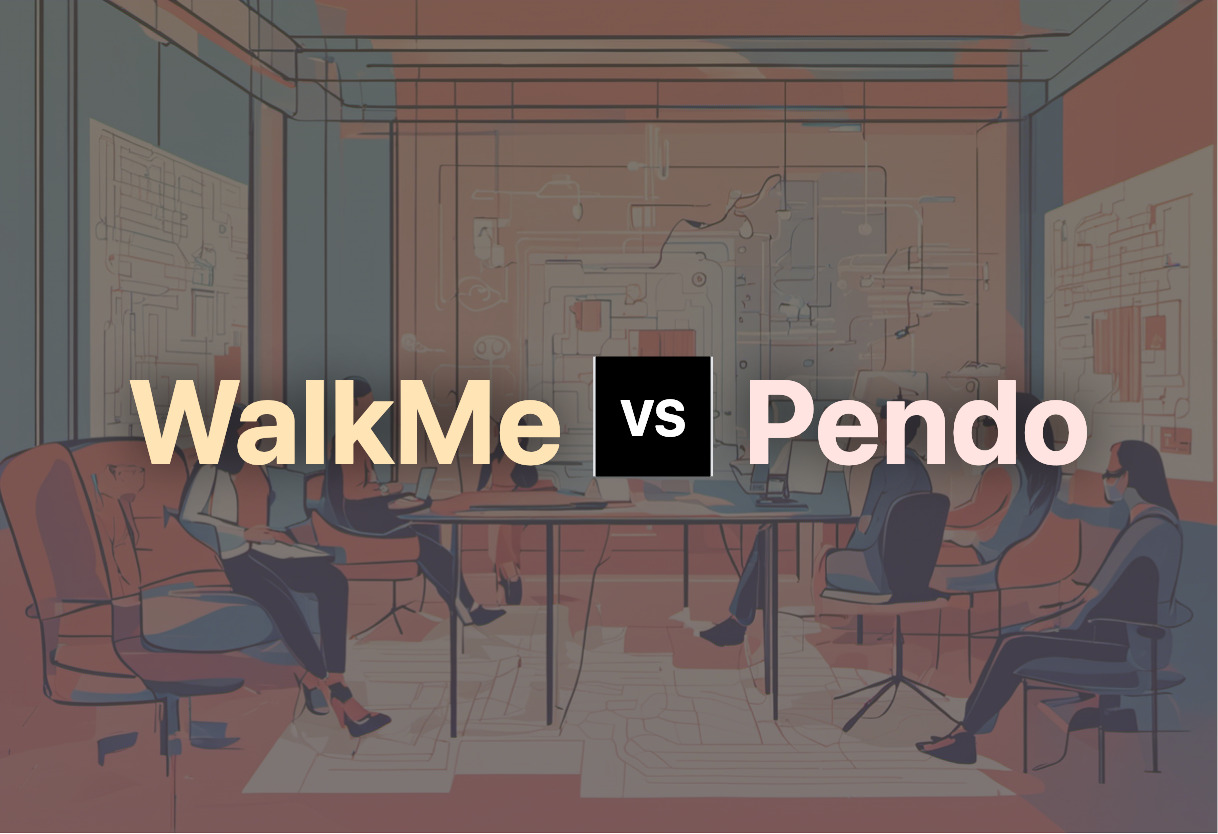When comparing WalkMe with Pendo, WalkMe is ideally suited for complex onboarding and training tasks due to its proprietary ‘Smart Walk-Thrus’ feature and extensive customization. Its application in form-based interfaces is particularly robust. Conversely, Pendo shines in capturing product usage data, audience targeting, and enhancing tailored customer experiences. Its compatibility with various platforms and integrations make it versatile.

Key Differences Between WalkMe and Pendo
- WalkMe uses a Digital Adoption Platform (DAP) with an emphasis on remote learning and training. Pendo is a product experience platform focusing on product usage data, behavior analysis, and in-app messaging control.
- WalkMe features ‘Smart Walk-Thrus’ for interactive user guides and an improved user experience, while Pendo uses audience targeting and customizable guides for enhanced customer interaction.
- The WalkMe platform is best suited for complex, form-based applications, while Pendo works well for optimizing digital experiences across diverse platforms, including Linux, Mac, and Windows.
- Both platforms offer strong support but differ in cost, with Pendo offering a Free or Starter package, and WalkMe requiring a more significant upfront investment.
| Comparison | WalkMe | Pendo |
|---|---|---|
| Purpose | Digital Adoption Platform (DAP) | Product experience platform |
| Key Technology | Artificial Intelligence, Machine Learning | Product usage data capture, Behavior Analysis |
| Main Use | Remote Learning, Training, Onboarding | Digital experiences optimization, Software adoption |
| Additional Features | In-app onboarding, Tool tips creation | In-app messaging control, Feedback aggregation |
| Market Focus | Organizations, Educational Institutions | Software developers, IT firms, E-commerce |
| Benefits | Reduced training time, Increased platform engagement | Customer experience enhancement, Decreased support tickets, Revenue growth |
| Challenges | Complex navigation, High IT support demand | Pricing documentation, App functionality |
| Deployment Improvement | User experience enhancement using DAP | Superior product adoption, Customer retention efficiency |
| Measurable Impact | Reduces B2B support tickets by 25% | Decreases support tickets by 15%, Reduces customer churn by 5% |
| Cost | Expensive upfront investment | Packages: Free, Starter ($7,000/year), Growth (custom), Portfolio (custom) |
What Is WalkMe and Who’s It For?
A premier AI-driven Digital Adoption Platform (DAP), WalkMe is a user interface optimiser designed for remote learning and onboarding. It’s experiencer-rich features like in-app onboarding, tool tips creation, and seamless software updates comprehension makes it an ideal choice for organizations looking for training/onboarding, and educational institutions for remote learning.
WalkMe brings down training time and maximizes platform engagement while reducing support demand. Despite its complex navigation and dated UI, it’s Smart Walk-Thrus feature and customization capacity make it a powerful learning tool.

Pros of WalkMe
- Reduced training time
- Increased platform engagement
- Lowered support demand
- Customizable UX
- Smart Walk-Thrus for interactive learning
Cons of WalkMe
- Complex navigation
- Dated User Interface
- High IT support demand
- Expensive upfront investment
What Is Pendo and Who’s It For?
Pendo, a product experience platform, is tailored for capturing product usage data, behavior analysis, feedback gathering, and in-app messaging control. It’s high compatibility with various platforms and browsers makes it a first-choice for software developers, IT firms, e-commerce, marketing, media, education, and government agencies.
It offers reductions in customer churn, boost in revenue, and superior product adoption alongside a decrease in support tickets by 15%. Despite known issues like app functionality and delays in data refresh, its project visualization feature and intuitive Kanban boards make it instrumental in project management.

Pros of Pendo
- Product usage data capturing
- High compatibility with platforms and browsers
- Decreases support tickets by 15%
- Intuitive Kanban boards
- Highly customizable
Cons of Pendo
- App functionality
- Delay in data refresh
- Pricing documentation
WalkMe vs Pendo: Pricing
WalkMe requires an upfront investment, delivering value and benefits in the long run, whereas Pendo offers varied packages: Free, Starter at $7,000 per year, and custom Growth and Portfolio plans.
WalkMe
WalkMe offers a feature-rich digital adoption platform relevant to user interface optimization, contributing to improved user experience and self-sufficiency. However, this technology comes at a premium, requiring a significant upfront investment to reveal its benefits effectively. Though it may appear costly, it has proven to reduce B2B support tickets by over 25% and aims to reduce in-person training needs and training time by half. This eventually translates to budget reallocation from support and training towards other critical areas, a return on investment that needs to be taken into account when considering its pricing.
Pendo
Pendo, a product experience platform, caters it’s pricing to a wider audience by offering a Free package and a Starter package priced at $7,000 per year. For enterprises requiring more substantial build-ups, custom pricing is offered under Growth and Portfolio plans. The cost is justified by the striking benefits it provides – reduction in customer churn by 5% and support tickets by 15%, improved customer retention, and enhanced product adoption leading to overall revenue growth.
WalkMe or Pendo – What’s The Better Fit?
In the battle of superior digital user experience, WalkMe and Pendo stride mightily. Here’s our opinionated verdict for different audience segments:
IT & Software Development Firms:
Given the imperative for technologically coded experiences, Pendo seems a bright choice. It presents precise control over in-app messaging and identifying user behavior. The custom audience segmentation can target specific interactions. Yet, consider the steep price tag.

Educational Institutions:
For the educational realm, WalkMe sweeps the floor. Its DAP lends itself beautifully to remote learning, with interactive ‘Smart Walk-Thrus’ and customizable user guides. Despite its slightly vexing navigation, the educational outcomes preponderate.

E-commerce and Marketing Agencies:
Where digital interaction is king, Pendo shines again. Its proficiency in capturing product usage data, feedback aggregation, and managing in-app messaging makes it a potent tool. Factor in the available integration with marketing staples like HubSpot and Intercom.

Large Organizations for Training/Onboarding:
WalkMe wins hands down here. Its design aids optimal employee training with reduced time and support demand. The in-app onboarding and seamless tool tips creation are additional windfalls. Organizational adoption, however, may warrant a learning curve.

Decidedly, Pendo excel for data-driven experiences while WalkMe makes the cut for educational and training scenarios. Make your choice wisely.
Patrick Daugherty
Content writer @ Aircada. Merging AR expertise with a love for late-night gaming sessions.





